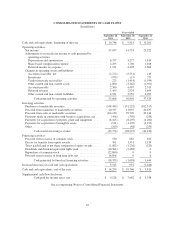Apple 2013 Annual Report Download - page 55
Download and view the complete annual report
Please find page 55 of the 2013 Apple annual report below. You can navigate through the pages in the report by either clicking on the pages listed below, or by using the keyword search tool below to find specific information within the annual report.Warranty Expense
The Company generally provides for the estimated cost of hardware and software warranties at the time the
related revenue is recognized. The Company assesses the adequacy of its pre-existing warranty liabilities and
adjusts the amounts as necessary based on actual experience and changes in future estimates.
Software Development Costs
Research and development costs are expensed as incurred. Development costs of computer software to be sold,
leased, or otherwise marketed are subject to capitalization beginning when a product’s technological feasibility
has been established and ending when a product is available for general release to customers. In most instances,
the Company’s products are released soon after technological feasibility has been established. Costs incurred
subsequent to achievement of technological feasibility were not significant, and software development costs were
expensed as incurred during 2013, 2012 and 2011.
Advertising Costs
Advertising costs are expensed as incurred and included in selling, general and administrative expenses.
Advertising expense was $1.1 billion, $1.0 billion and $933 million for 2013, 2012 and 2011, respectively.
Share-based Compensation
The Company recognizes expense related to share-based payment transactions in which it receives employee
services in exchange for (a) equity instruments of the Company or (b) liabilities that are based on the fair value of
the enterprise’s equity instruments or that may be settled by the issuance of such equity instruments. Share-based
compensation cost for restricted stock units (“RSUs”) is measured based on the closing fair market value of the
Company’s common stock on the date of grant. Share-based compensation cost for stock options and employee
stock purchase plan rights (“stock purchase rights”) is measured at the grant date and offering date, respectively,
based on the fair-value as calculated by the Black-Scholes-Merton (“BSM”) option-pricing model. The BSM
option-pricing model incorporates various assumptions including expected volatility, estimated expected life and
interest rates. The Company recognizes share-based compensation cost over the award’s requisite service period
on a straight-line basis for time-based RSUs and on a graded basis for RSUs that are contingent on the
achievement of performance metrics. The Company recognizes a benefit from share-based compensation in the
Consolidated Statements of Shareholders’ Equity if an incremental tax benefit is realized. In addition, the
Company recognizes the indirect effects of share-based compensation on research and development tax credits,
foreign tax credits and domestic manufacturing deductions in the Consolidated Statements of Operations. Further
information regarding share-based compensation can be found in Note 9, “Benefit Plans” of this Form 10-K.
Income Taxes
The provision for income taxes is computed using the asset and liability method, under which deferred tax assets
and liabilities are recognized for the expected future tax consequences of temporary differences between the
financial reporting and tax bases of assets and liabilities, and for operating losses and tax credit carryforwards.
Deferred tax assets and liabilities are measured using the currently enacted tax rates that apply to taxable income
in effect for the years in which those tax assets are expected to be realized or settled. The Company records a
valuation allowance to reduce deferred tax assets to the amount that is believed more likely than not to be realized.
The Company recognizes the tax benefit from an uncertain tax position only if it is more likely than not the tax
position will be sustained on examination by the taxing authorities, based on the technical merits of the position.
The tax benefits recognized in the financial statements from such positions are then measured based on the
largest benefit that has a greater than 50% likelihood of being realized upon settlement. See Note 5, “Income
Taxes” of this Form 10-K for additional information.
53
























